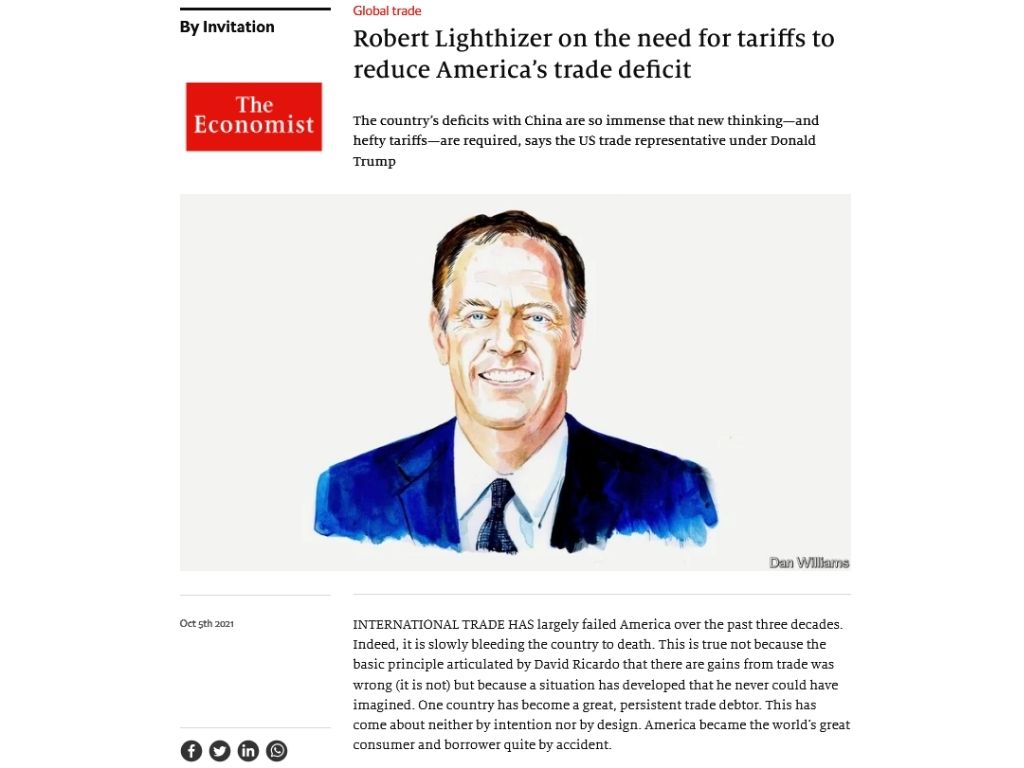The September goods and services trade deficit rose substantially last month – by a whopping $8.1 billion – to come in at $80.9 billion as more ships waiting at sea off the coast of California will make this year our first-ever $1 trillion deficit in manufactured goods trade with the world.
The goods deficit for September was the highest all year at $98.15 billion, the Bureau of Economic Analysis said on Thursday. That’s up from a goods deficit of $89.23 billion for August, which was actually revised upwards from $88.16 billion. The $98.15 billion deficit for September is the highest monthly deficit ever recorded in U.S. history.
“In September the U.S. racked up a world record trade deficit exceeding $80 billion, and a goods deficit frighteningly close to $100 billion a month, all of this representing the loss of hundreds of thousands of jobs,” said CPA chief economist Jeff Ferry. “Meanwhile, Americans are unable to buy many goods because Asian factories are shut down, or finished goods are stacked up at the ports unable to move, or they are sitting in filthy, polluting container ships in the bays outside Los Angeles and Seattle. The government must wake up to the unholy mess in our supply chain and begin rebuilding the domestic U.S. economy.”
To put that $1 trillion figure in perspective, the Mexican economy’s total GDP output was $1.076 trillion last year. The U.S. is effectively importing more than it exports by the equivalent of what the entire Mexican economy produces. If the U.S. imported less, that would mean more production at home, more jobs, and more prosperity.
A strong dollar has muted most of the trade war tariffs, making it more enticing for American companies to source cheaply overseas, especially from Asian markets. It also makes it more enticing for those companies to invest overseas, where the dollar goes much farther.
September exports totaled $207.6 billion, down from $213.7 billion in August while imports rose to $288.5 billion from August imports of $287 billion. Imports would have been even higher, but for the bottlenecks at the ports.
Overall, the September increase in both the goods and services deficit rose 11.2% in September with the year-to-date trade deficit (goods and services) rising 33.1% over 2020 to $638.57 billion. A positive services balance keeps the overall deficit lower. Service exports include things like foreign students paying for American education costs, and foreign tourists going to Disney World.
Exports increased $274.1 billion or 17.4% year-to-date, but imports increased $432.8 billion or 21.1%.
September Trade Gaps
The September figures show trade surpluses with South and Central America ($3.8 billion),
Hong Kong ($1.5 billion), and Brazil ($1.2 billion).
Meanwhile, our monthly goods deficit with China ($31.5 billion) was bigger than the deficit we have with the European Union ($18.7 billion) and Mexico ($8.8 billion) combined.
The U.S. also recorded a deficit with Germany ($5.7 billion), Japan ($5 billion), Canada ($4.7 billion), South Korea ($3.8 billion), and Taiwan ($3.8 billion), to name a few of the biggest ones.
- The deficit with China increased $3.4 billion to $31.5 billion in September. Exports decreased
$0.2 billion to $11.0 billion and imports increased $3.2 billion to $42.6 billion. - The deficit with Mexico increased $2.3 billion to $8.8 billion in September. Exports decreased
$1.7 billion to $22.4 billion and imports increased $0.5 billion to $31.3 billion. - The deficit with Japan decreased $0.6 billion to $5.0 billion in September. Exports decreased
$0.2 billion to $6.0 billion and imports decreased $0.8 billion to $11.0 billion
Southeast Asia is staging a huge comeback thanks in large part to China investment, and multinationals sourcing from there to avoid mainland China tariffs. Weak currencies make it incredibly cheap to source from these three countries whose trade gaps look large simply because they don’t buy much of anything from the U.S.
Here is what our year-to-date trade deficit looks like with the resurgent Asian Tigers.
Vietnam: $65.48 billion
Malaysia: $31.2 billion
Thailand: $25.56 billion
All three have become huge exporters of solar panels to the United States since anti-dumping/countervailing duties were imposed on Chinese firms operating in mainland China. The exporters are mostly the same Chinese firms, but operating out of other Asian locations.
As usual, the top five biggest imports for the month in terms of value were, in order, pharmaceuticals, cell phones, autos, and automotive parts and computers. Most of our exports are the same type of goods, as supply from abroad is used to make the end product that is sold overseas when not sold domestically.
The biggest exports from the month of September were, in order of value, pharmaceuticals, industrial machines, semiconductors, autos, and electronics.
Overall, September’s figures show that the U.S. economy is far and away the world’s leading consumer market. Coupled with a strong dollar that makes corporate investment and supply chain sourcing cheaper abroad, the U.S. is destined to ever-widening trade gaps not only with Asia but with the EU and Mexico as well.
Last month, former USTR Robert Lighthizer said trade deficits of this magnitude would bleed the U.S. economy to death. Here’s a glimpse of that op-ed, published in The Economist magazine.














